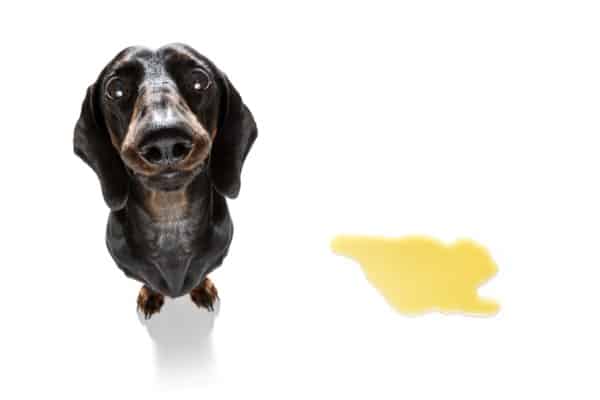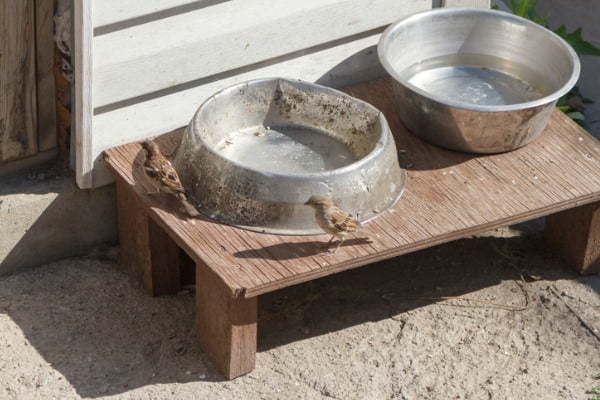How often do you check out your dog’s urine?

Sounds gross, right?
We’re not suggesting you get down on the ground with a magnifying glass every time your pup pees.
However, you should be paying attention to what your dog’s urine looks like.
Why you ask?
Dogs can’t tell you when something is wrong with them, at least not by speaking to you.
See also:
- Dog Peed on My Bed in Front of Me: Here’s What You Can Do
- Crystals in Dog Urine: A Sign of Trouble?
- Dog Leaking Urine When Lying Down: 7 Causes and What You Can Do Now
- Urinary Care Dog Food: Top 5 Diet Options for Optimal Urinary Health
- Urine Scald in Dogs: 5 Best Treatments
They have other ways of letting you know something isn’t quite right – and sometimes, that includes pet parents keeping an eye on their bathroom habits.
For instance, dark yellow urine in dogs is a sign that something’s up – it could be as simple as them being a little dehydrated, or it could indicate another problem that a vet needs to check on. More on this in a bit…
The question is:
What should dog urine look like when it’s healthy, and what things suggest there’s something unusual going on with your dog’s system?
We’ll cover all things pee in this article – it’s an awkward topic, but one pet moms and dads should familiarize themselves with.
If It’s Yellow, You Can Mellow
Dogs aren’t so different from us, and neither is their urine.
Yellow is the typical color of dog urine; most dogs have pale yellow-colored urine, as you do.
It can be very light and pale, which should raise no red flags for you.
If you know your dog drank a lot of water or maybe went for a swim recently, then very light yellow urine is just an indication they’ve had a lot of liquid.
Straw-colored urine is also typical. The darker it gets, the less hydrated your dog is.
So if you notice a more intense yellow color than usual, your pup might not be getting as much water as they should be.
One thing to look out for is urine that is as clear as water.
This could be an indication of diabetes or other conditions that prevent your pet’s renal system from concentrating urine properly.
If you’re unsure what’s expected, you can refer to a dog urine color chart.
My Dog’s Pee Is Orange

Orange urine can be a sign of moderate to severe dehydration or something more serious.
Dehydration can be caused by not enough water or even a dog frequently drinking it’s own urine.
Either way, you need to take action:
Gallbladder disease, pancreas, liver, or bile duct conditions can all cause the urine to turn orange.
Since each of these issues can be life-threatened if ignored, having your dog evaluated by a vet is essential.
Orange urine can also be an indication of jaundice in dogs.
If your dog is lethargic, refuses to eat or vomits, and is feverish, they must be seen by a vet immediately.
Jaundice also causes yellowing of the skin, which can be hard to spot in dogs because they’re covered in hair.
Checking their bellies where the hair is thin is a good way to check for yellow skin.
Since jaundice can signal something very serious, like poisoning or tumors, this isn’t a symptom you should ignore.
When urine is especially deep in color, it’s good to have a good pet urine stain remover on hand in case of any accidents you need to clean up!
Dark Brown Urine – a Medical Emergency

Dark brown urine in dogs is a reason to head to the vet immediately.
Even if the change in urine color is the only symptom they’re displaying, it can be the first warning sign that something is wrong.
What causes dark urine in dogs?
When the urine is very dark brown, it usually means damage to the organs or muscles.
This can be from toxins or poisons, and immediate treatment will give a better chance of recovery.
It needs urgent attention.
Dark urine can also appear to be black – a sign of blood loss. Only a vet can diagnose the cause, which can range from tumors to obstructions.
Since poisoning is often the culprit of dark brown urine, it is recommended that you take your dog to the vet if you suspect they ingested something toxic.
Substances in common painkillers, poisons like those in snail bait, and some plants can cause muscle damage.
Trauma can also cause muscle damage that leads to dark brown urine – if your dog has had an accident, they should be seen by a vet before symptoms have a chance to appear.
Red or Pink Urine
These colors in the urine usually mean blood is being passed.
Urinary tract infections and bladder infections are usually the reason, although trauma or obstructions can also be the culprits.
Other signs of a UTI or bladder inflammation include frequent urinating in small volumes, straining to urinate, and smelly urine.
If an infection is not present, blood in the urine can be a symptom of bladder or kidney stones, tumors, exposure to pest poisons, and liver failure.
Although the more common cause is a simple UTI, it’s essential to have a vet rule out other causes for pink or red urine.
Changes in Urine
Aside from what we’ve already covered, any change in your dog’s urine warrants a second look.
Colors like red, orange, or dark brown to black need to be reported to a vet.
Even cloudy mucus in dog urine is important to spot. Take notice if your dog smells like urine, which is another indication something is out of whack.
What if the changes are subtle?
If your dog’s urine remains in the yellow range, any changes are more than likely due to changes in hydration.
We might try to get our eight glasses of water a day, but dogs aren’t always as aware of their water intake needs.
This can cause some slight variations in their urine color.
Most dogs will drink as soon as they get thirsty, but some things can prevent them from drinking enough water.
Their Bowl is Dirty

A dog wants a clean water bowl as much as we appreciate clean drinking glasses.
Remember:
Dogs are often drooly. They can salivate a lot into their dish as they lap up water. Their bowl can become gooey after only a few uses.
A good rule to follow is to rinse your dog’s bowl each time you refill it.
Keeping it full of fresh water will also encourage them to drink when they’re thirsty.
Giving it a thorough wash 2-3 times a week will also keep it inviting enough that your dog will always drink as they please.
Many dog dishes are dishwasher safe, so investing in one is a good idea if you don’t have time to clean their dish frequently by hand.
Make sure they have a backup dish of water while the other is going through the dishwasher cycle.
Their Water Isn’t the Right Temperature

Some dogs aren’t so picky about the temperature of their water, and some are.
It’s up to you to find out which type your dog is.
Water that is too warm can put off some dogs, and cold water or ice water can be equally unappealing.
If your dog has teeth issues, too warm or too cold water could be causing them pain.
They can have sensitive teeth as well, just like we do.
On the other hand, offering cold water with a bit of ice can be very tempting for some dogs, especially during hot weather.
There’s been a rumor floating around the dog community for a while that ice water, in general, is not suitable for dogs.
More specifically, it was thought to put dogs at risk for a dangerous condition called bloat.
It’s false.
The truth is that drinking too fast or too soon after physical activity is the real cause, not ice or cold water.
So offering your large dog some cool water after they have a chance to catch their breath or recover from hot weather isn’t a dangerous thing to do.
They’re Nervous

Many things can put a dog off of their food or water because they’re anxious.
It could be a new addition to the family, guests, or a new house.
If that new family member is another dog, sharing a water bowl is something your dog might need time to adjust to.
It’s normal:
You can encourage healthy hydration by moving your dog’s water dish to their crate or another safe space.
If they’re not on board with sharing with a new puppy yet, you can provide a second bowl while your dog warms up to the new bundle of fur.
Dogs traveling or have moved to a new place can take some time to calm down – they can be put off their food or water for quite a while.
Most will say yes to the water dish before they become severely dehydrated.
Let Them Go Potty More Frequently
Along with improving their water intake, it goes without saying we want our canine companions to relieve themselves on healthy schedules.
Urinating more frequently can help their bodily function process when it comes to hydration.
How long a dog holds their pee shouldn’t be up to your busy life schedule, but as much as you can help it, more in line with what is better for them and their urinary health.
If you suspect your dog isn’t getting enough potty breaks, you can check if their pee is foamy, one indication that they’ve waited too long and the urine is coming out more quickly than normal when it’s time to go.
If you have an issue with your dog not wanting to go outside and pee, then find out what’s going on there, as it can most certainly have an impact.
It’s Your Job to See the Pee
Yes, giving your dog’s pee a look is something you should do every day.
Often, changes in urine are the first indicator of a problem – and the problems can be serious.
The quicker you notice an issue, the better the outlook for your dog.
When they do their business in the grass, it can be hard to notice if something is amiss.
Luckily, dark brown, black, or bloody urine is usually easy to spot as long as you’re willing to take a closer look and examine it.
It’s ok to be your own vet on this level. And if you’re worried about whether dog urine is harmful to us humans, then learn more about that.
The vet is the best option.
Evaluating the cause of dark urine in dogs is essential.
Letting the vet figure out the root issue is best if there’s an abnormal color in your dog’s pee.
As long as their urine stays somewhere in the yellow spectrum, encouraging them to drink more is something you can easily do at home.
